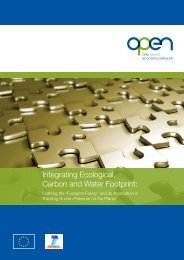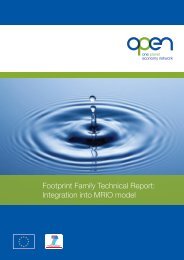OPEN: EU Scenario Storylines Report: - One Planet Economy Network
OPEN: EU Scenario Storylines Report: - One Planet Economy Network
OPEN: EU Scenario Storylines Report: - One Planet Economy Network
You also want an ePaper? Increase the reach of your titles
YUMPU automatically turns print PDFs into web optimized ePapers that Google loves.
Industrial policy<br />
� Measures to improve the resource-efficiency of production processes.<br />
Resource efficiency improvements are driven by various measures, for example<br />
through the early strengthening and widening of the Eco-Design Directive to<br />
include industrial inputs beyond energy and by strengthening public procurement<br />
regulations across <strong>EU</strong> Member States. Regulations on efficiency are promoted in<br />
tandem with increased efforts on recycling to ensure that recycling does not<br />
become an end in itself.<br />
� Recycled content manufacturing regulation. Industry and the manufacturing<br />
sectors were required to use a minimum of 20% recycled material in products by<br />
2020 (increased to 50% by 2040). The regulation applied also to products<br />
manufactured outside of the <strong>EU</strong> at facilities under ownership or control by <strong>EU</strong><br />
companies. In addition, an advanced ―Take back‖ law was applied to nearly all<br />
commercial products sold.<br />
� Expansion of extended producer responsibility (EPR) obligation beyond<br />
Waste Electrical and Electronic Equipment (WEEE) directive 2002/96/EC. 6<br />
The list of applicable priority products under WEEE was expanded to include all<br />
products composed of 50% or greater plastic, 50% or greater metals, as well as<br />
all products containing any mercury, batteries, all medical products, and all<br />
carpeting.<br />
Water resources<br />
� Full cost recovery water pricing. (Pricing covers financial, resource and<br />
environmental costs). Under the <strong>EU</strong> Water Pricing Directive, Member States are<br />
required to ensure full cost recovery water pricing in household, agricultural, and<br />
industrial (including mining) sectors. Under a stepwise increase between 2015 and<br />
2050, average water pricing for public water/wastewater services in non-water<br />
scarce <strong>EU</strong> regions is 5 €/m³; in water scarce regions, it is in the order of 8 €/m³.<br />
� Water pricing and removal of water-related energy subsidies. Existing<br />
water pricing subsidies for industries and agriculture were reduced, eliminated<br />
and refocused on water efficiency R&D (reduced by up to 50% by 2030; 100% by<br />
2050).<br />
� Measurement of water intensive products. A water intensity labelling scheme<br />
was introduced (for non-food goods) to raise consumer awareness and support<br />
retailer pressure on the supply chain to provide less water-intensive products. The<br />
labelling includes a measurement of both water and carbon footprints of products,<br />
to prevent negative trade-offs.<br />
Energy and transport<br />
� Market reforms. Implemented very early on (from 2012) to provide a level<br />
playing field for investment in demand side management, on-site generation and<br />
smart grid infrastructure.<br />
� Renewable energy and fossil-fuel power plants incorporating CCS/CCR.<br />
On the supply side, society was not prepared to accept any new conventional<br />
coal-fired power stations, and none are built from 2011 onwards. In addition to<br />
the decentralisation of the energy supply infrastructure, the rapid uptake of large<br />
scale renewable energy technologies is enabled by the combination of rapid<br />
technological innovation and targeted measures. The replacement of existing<br />
6 See, e.g., ―Priority products and materials report‖ at http://www.unep.org/resourcepanel/<br />
Page 21 of 57





